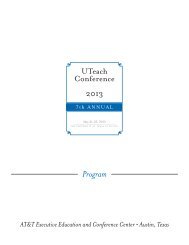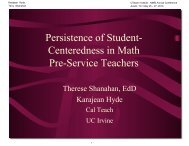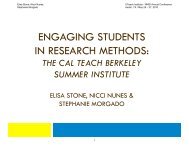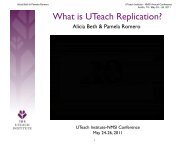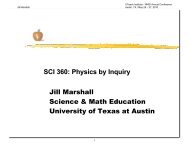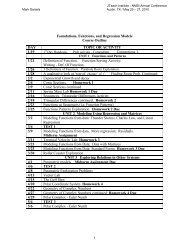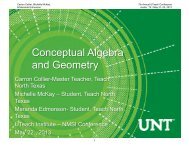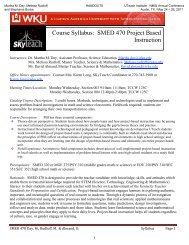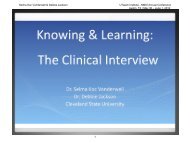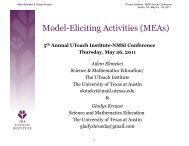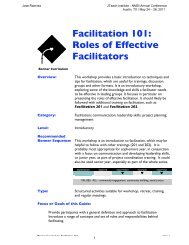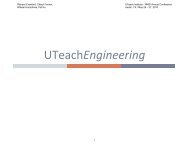Pinhole Camera Design Challenge Instructor Notes. Jill Marshall ...
Pinhole Camera Design Challenge Instructor Notes. Jill Marshall ...
Pinhole Camera Design Challenge Instructor Notes. Jill Marshall ...
You also want an ePaper? Increase the reach of your titles
YUMPU automatically turns print PDFs into web optimized ePapers that Google loves.
<strong>Jill</strong> <strong>Marshall</strong> &<br />
Gretchen Edelmon<br />
Handout - 1<br />
<strong>Design</strong> <strong>Challenge</strong> <strong>Instructor</strong> <strong>Notes</strong><br />
UTeach Institute - NMSI Annual Conference<br />
Austin, TX / May 24 – 26, 2011<br />
‐ Geometry: demonstrating applications of similar triangles, trig functions, <br />
ratios <br />
‐ Physics: basic optics lessons on properties of light and image formation <br />
‐ Chemistry (version with film paper): optical excitation of molecules <br />
‐ Biology: operation of human physiological systems (w added lens as a model <br />
of the eye), demonstration of variation within species (viewing range to face <br />
size ratios) <br />
2. This activity can be linked to the UTeachEngineering high school curriculum module tied <br />
to the historical development of imagers and culminating in the development of an aerial <br />
camera. <br />
3. Depending on the audience, you might want to have sample models available for the <br />
students to view as scaffolding. <br />
4. Students can either design their own performance requirements or you can determine <br />
them, depending on the time available. For an indoor environment, the target ‘object’ can <br />
be an image projected on an overhead screen. Should be 0.5‐1m in height when projected. <br />
Viewing distance can be set at a convenient number of meters away. Viewing of more <br />
distant objects (scenes) can be done through a window or outside the classroom (looking <br />
outward from a shaded area onto a lit area.) <br />
5. Students can make a reflection (shoe box) camera or a transmission (oatmeal canister) <br />
camera. In the reflection model, the pinhole and the viewing aperture are on the same side <br />
of the camera box. The viewer is facing directly away from the target object looking into the <br />
camera box through the viewing aperture. It is important that the pinhole be far enough <br />
away from the viewing aperture not to be blocked by the viewer’s head, but close enough to <br />
the viewing aperture that the image on the opposite (inner) wall of the camera box is <br />
within the viewer’s field of view. In the transmission camera, the opaque (velum/wax <br />
paper/clear plastic like oat meal canister lid)) viewing screen is between the eye and the <br />
pinhole, which is pointed directly at the target object. <br />
6. It will be necessary to block light from entering the camera other than through the <br />
pinhole. It will be helpful to have a white surface inside the box where the image will form. <br />
7. This activity can be reworked as a 5E lesson asking students how their eyes work or <br />
what an image will look like through a pinhole, guiding students to build the system and <br />
explore, and then build a physical model to share with classmates showing how the image <br />
is formed. <br />
8. Accommodations for students with visual impairment might include building (or having <br />
your students build) a physical model using string or dowels to represent rays of light. <br />
9. Additional reflections might include comparing the design of a physical object with the <br />
design of a process, or the design of a lesson. <br />
10. Alternate version: <br />
On the preview day have students think/pair/share on differences between science and <br />
engineering, and debate the value of design in learning science and mathematics. <br />
As homework, students read Barnett (2005) and respond to focus questions. <br />
3



